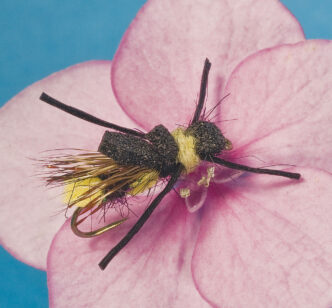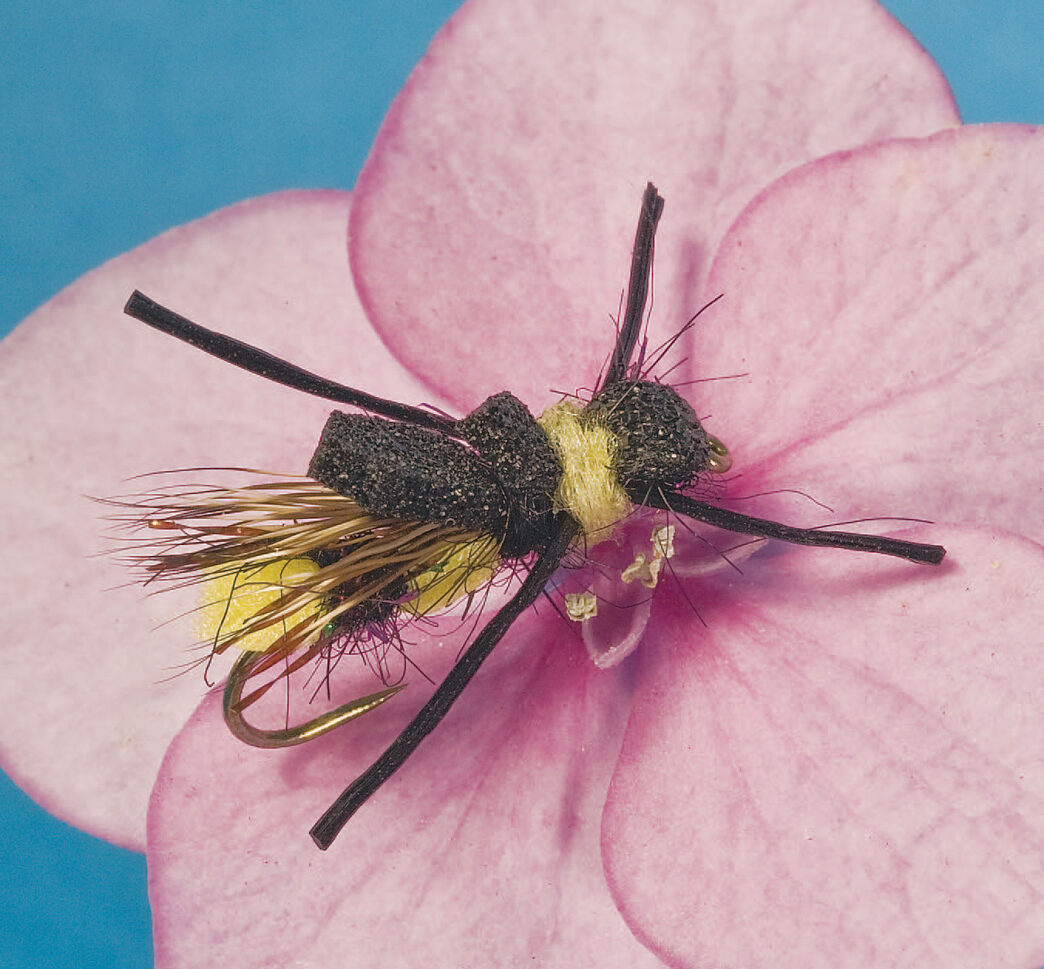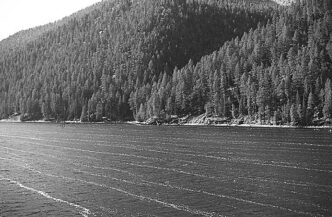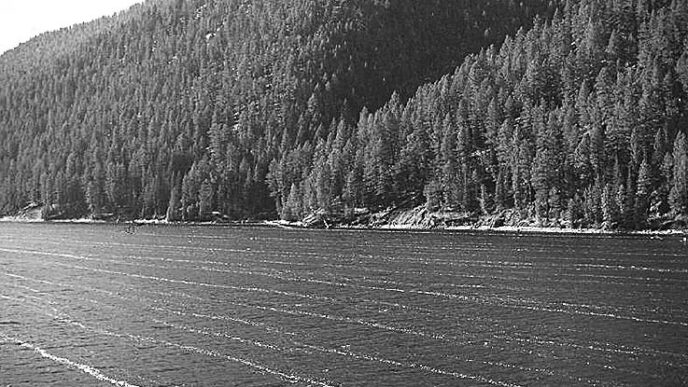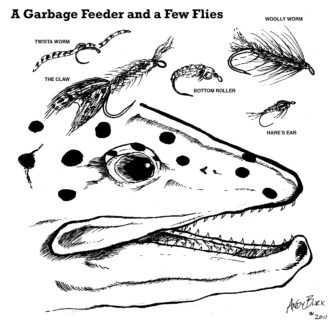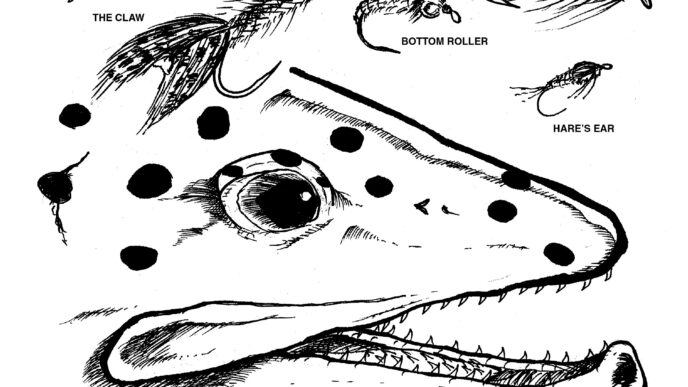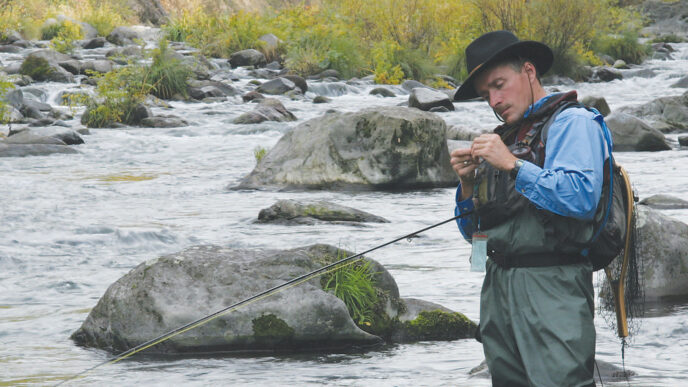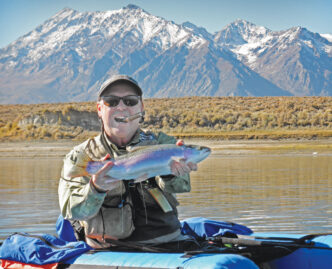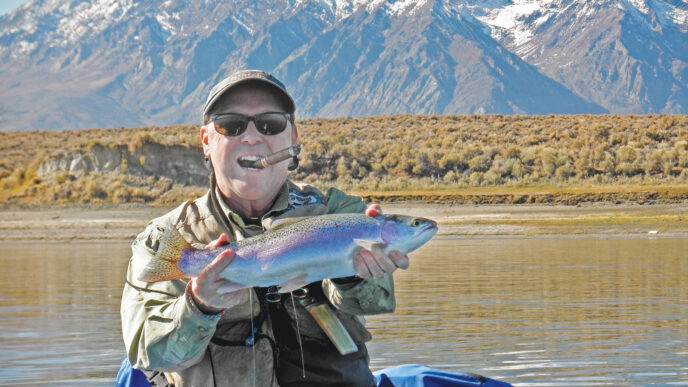We trout hunters understand the importance of terrestrials. Blown-in ants, bees,
beetles, grasshoppers, or other landlubbers that are unfortunate enough to end up floating on (or sinking into) our favorite stillwater venues or streams are a major component of the various food chains available to trout. I went to school on this tidbit of angling wisdom many, many years ago when, as a neophyte stillwater angler, I found myself float tubing an alpine lake on a breezy afternoon. Trout were rising all around me as I feverishly (and vainly) tried each of the dry-fly patterns in my box, lengthened leaders with spidery tippets and generally throwing the book at them. When I finally woke up and noticed winged ants futilely squirming in the lake’s surface tension, the “hatch” was on the wane, and the trout were only sporadically feeding at the surface.
Later, at the evening campfire, I summoned the remaining scraps of my courage and asked my companion/mentor what had worked so well for him. A man of few words, he handed me a fly box filled with terrestrials — including a corner that held a large selection of ant patterns. “Don’t,” he said as he nibbled on a chocolate-and-melted-marshmallow concoction smashed between two graham crackers, “ever leave home without a smattering of those critters.” Although chastened, I had to ask: “Uh, can I . . .” “Yeah, yeah, take a couple of those black winged ants.” And so I did, and so did the trout the next day. Schooling completed, I vowed to follow suit and create my own terrestrial box — which, morphed with experience and significantly more compact, I still carry with me.
Now, thanks to Phil Fischer, my terrestrial box sports something new — his Foam Yellow Jacket. Incidentally, if you have ever been stung by a yellow jacket (I have), you’ve probably wondered why God created these annoyances and others, such as mosquitoes. Now, by Jove, I know! Trout eat them, which in turn provides us with the opportunity to fool trout with concoctions cleverly imitating them.
Born and raised in the San Francisco Bay Area, Phil Fischer is an avid fly angler and tyer. With over 40 years of fly-fishing and fly-tying experience, Phil has fished for trout extensively throughout California and the Western United States. He was tutored by master fly tyer André Puyans and taught fly-tying classes at Creative Sports in Pleasant Hill for a number of years. He owns Phil’s Custom Trout Flies and has fly customers throughout the country who count on his expertise in solving fly-fishing puzzles on their own home waters.
Solving on-stream angling puzzles fascinates me. Whether it’s reading the water properly, discerning on what food source the fish are keying, selecting the proper type and size of fly, or determining the best strategy for the pocket or stretch I intend to fish next, I am driven to parse out a solution. So when Phil recently presented a program on solving angling puzzles to the flyfishing club I frequent, I was all ears. Phil skillfully wove together his views, from a fly tyer’s perspective, on why certain patterns work well and why others don’t. He broke down hatches into their various components and time periods and connected the dots between those factors and pattern selection by describing mayfly, stonefly, and caddisfly life cycles and representative matching flies. This type of invaluable practical information is the result of experience and long hours of paying your dues on the water.
Phil is one of those fly tyers whom other tyers (and nontyers) enjoy watching. He has managed to blend a sense of humor, a friendly and engaging personality, the humility that comes with the wisdom of finally understanding that, in the long view, we really don’t know all that much, and a thoughtfully creative approach to our sport. He is a valued member of my team of tyers for the Sacramento International Sportsmen’s Exposition How-to Center. Here’s what Phil has to say about his Foam Yellow Jacket fly pattern and why he considers it so effective that it should be in every fly fisher’s fly box.
“The nasty little critter we call the ‘yellow jacket’ can be described as any of several small wasps of the family Vespidae that have yellow and black markings and usually nest in the ground. The bad news is that yellow jackets are at best annoying and unpleasant — who hasn’t sat by a Sierra lake at lunchtime and been buzzed by one or more of these pesky critters. The good news is that they can help solve an angling puzzle.
“During the heat of mid and late summer, fishing can get tough. During these dog days, fishing something different can pay dividends. Instead of longing for early season fishing, when virtually any pattern drifted over a Sierra trout is taken with gusto, concentrate on solving the puzzle of how to coax reticent, lethargic trout to the surface. By August and September, with warmer water and fish that have become educated about our normal go-to fly patterns, ants, beetles, hoppers, and other terrestrials should be on your radar screen. One of the problem solvers that is always in my summer fly box is my Foam Yellow Jacket.
“While hatches are thin during the dog days, yellow jackets are almost always active in the afternoons. Yellow jackets are often found on the edges of lakes and streams in damp areas as they take in water on hot days. Some of them end up in the water, especially when afternoon breezes develop. Clumsy and hapless in the surface film, they can tempt tough, but hungry and opportunistic trout up from the depths for an easy meal. Certainly, the Foam Yellow Jacket is a specialty pattern, Still, in the right situation, it can save an otherwise frustrating day.
“As I was designing the Foam Yellow Jacket, I recalled reading an article some years previously about the legendary upper Sacramento River angler Ted Fay, who used a yellow jacket pattern in downtown Dunsmuir many years ago with excellent results. While his version of a yellow jacket didn’t float, it did inspire me in my efforts to create a new and unique floating imitation. The result, which is an adaptation of a fly originally created by Bob Quigley, is the Foam Yellow Jacket. I have tested this simple-to-tie pattern with positive results.
“During those dog days, instead of tying on hoppers, ants, or other terrestrials (or heading for the hammock in the shade), I prefer to fish less common, nontraditional patterns such as the Foam Yellow Jacket in both lakes and streams. I generally cast this fly tight to the banks of streams and near bushy areas on the edges of lakes, where yellow jackets — and trout — hang out. Tie a few of these patterns and keep them in your fly box for those dog days, when nothing else seems to work.”
Materials
Hook: Size 12 2X-long dry fly hook, such as a TMC 5212
Thread: Black 6/0
Body components: Yellow 2-millimeter foam, then a dubbing mix of black rabbit/Antron and olive Ice Dub, then yellow Antron dubbing
Wings: Dark olive Krystal Flash underwing, then natural coastal deer hair
Head and overwing: Black 2-millimeter foam
Legs: Black Stretch Floss
Tying Instructions
Step 1: Pinch down the hook barb. Cut a 1/8-inch-wide strip of yellow foam approximately an inch long. Cut the corners off the rear of the foam to form a point. Tie in the foam just above the back of the barb with the point of the foam extending slightly past the bend of the hook. Wrap the thread forward over the foam for about 1/16 of an inch. Dub this area with the black dubbing mix. I blend my own dubbing mix for this pattern. I begin with a black rabbit and Antron mix as the base and add to it about 15 to 20 percent of a dark olive Ice Dub.
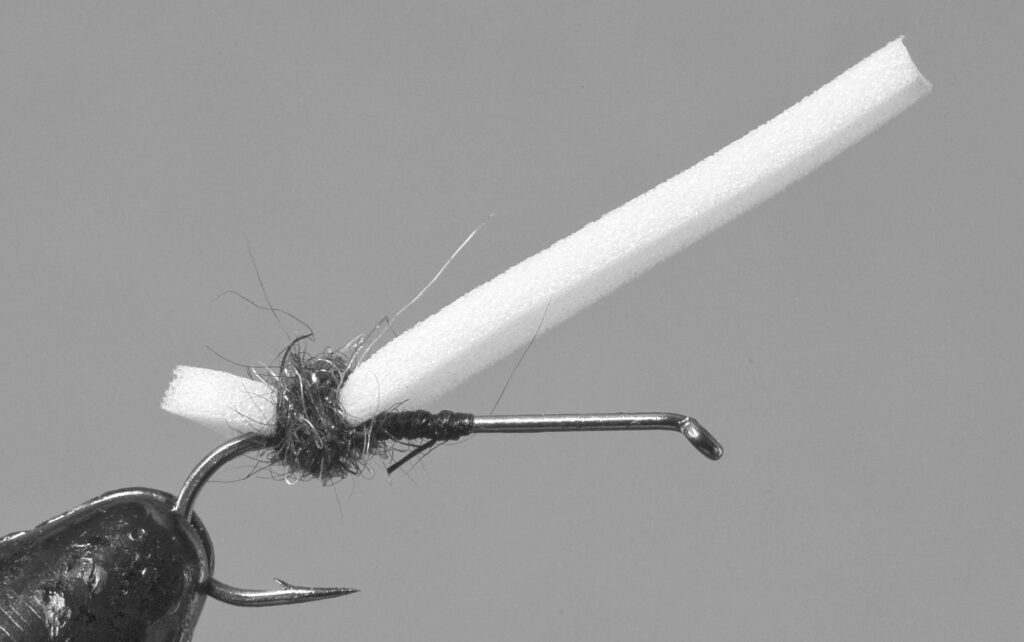
Step 2: Wind the yellow foam in a single wrap around the hook to form a yellow segment. Tie off the foam on top of the hook and clip off the excess. Your thread should be just a bit ahead of the center of the hook shank when this step is completed.
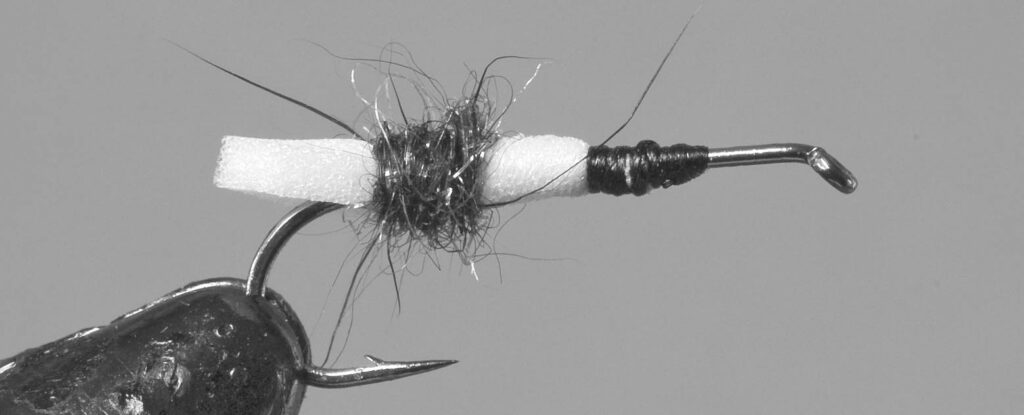
Step 3: Tie in 8 to 10 strands of olive Krystal Flash in front of the yellow segment to form an underwing and clip off the excess. The underwing should extend just slightly beyond the foam point at the rear of the fly.
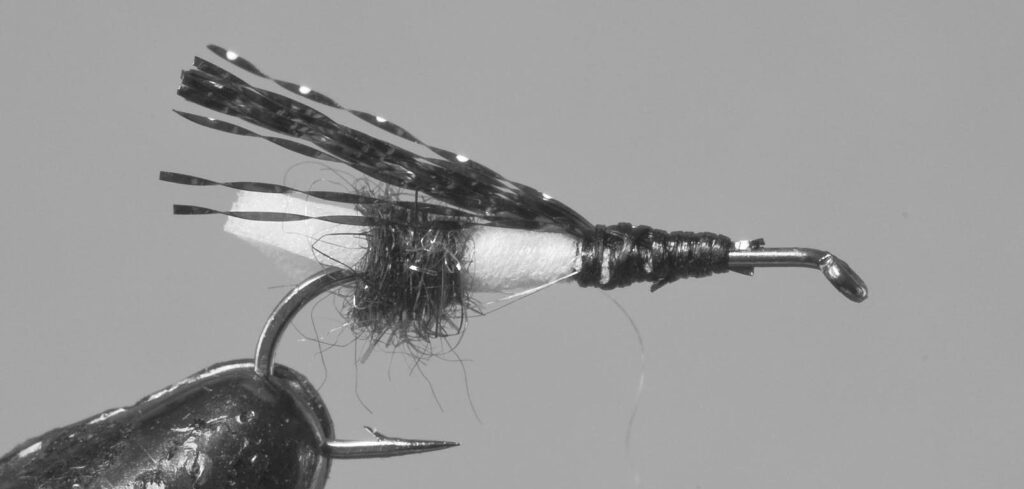
Step 4: Cut, clean, and stack a small clump of natural coastal deer hair. Tie the hair in at the wing-set position, which is just ahead of where you left your thread in Step 2. Wind the thread forward over the butts of the hair, ending just behind the hook eye. Trim the excess.
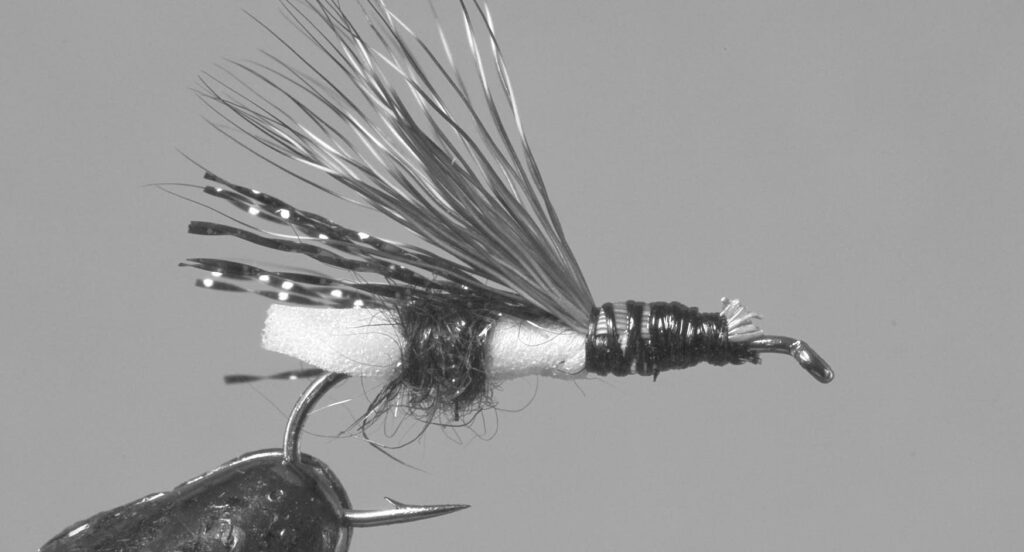
Step 5: Cut a 1/8-inch-wide piece of black foam. Clip the edges of the foam to form a point. Measure the foam so that the point of the foam extends rearward over the wing and just beyond the first blackdubbed area. With the foam in that position, tie it in at the eye of the hook, with the rest of the foam facing forward, over the eye, and wind the thread rearward over the foam to the front of the wing and yellow segment. There should be a long piece of the foam sticking out in front of the eye. Leave the thread at that point.
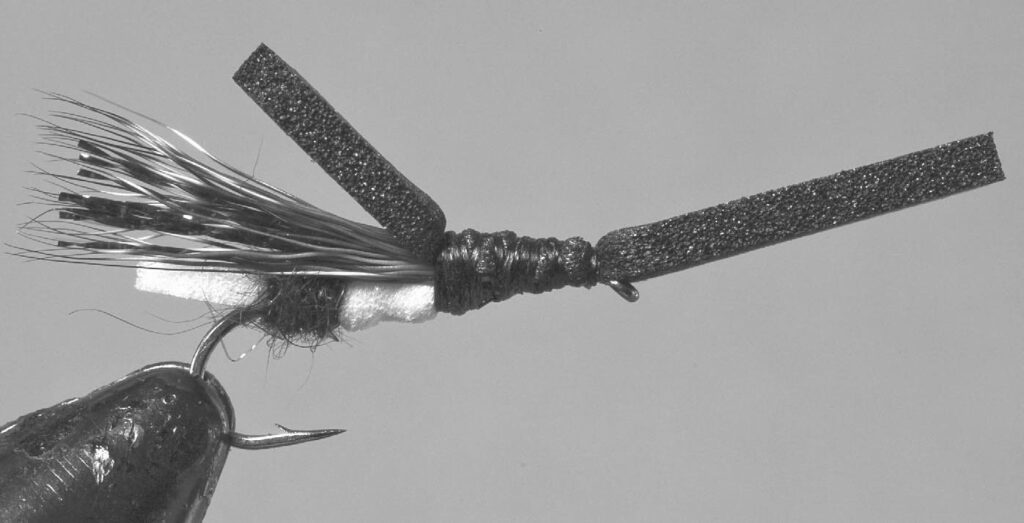
Step 6: With the black dubbing, dub forward over the thread wraps, then rearward. Leave your thread about halfway between the eye of the hook and the wing.
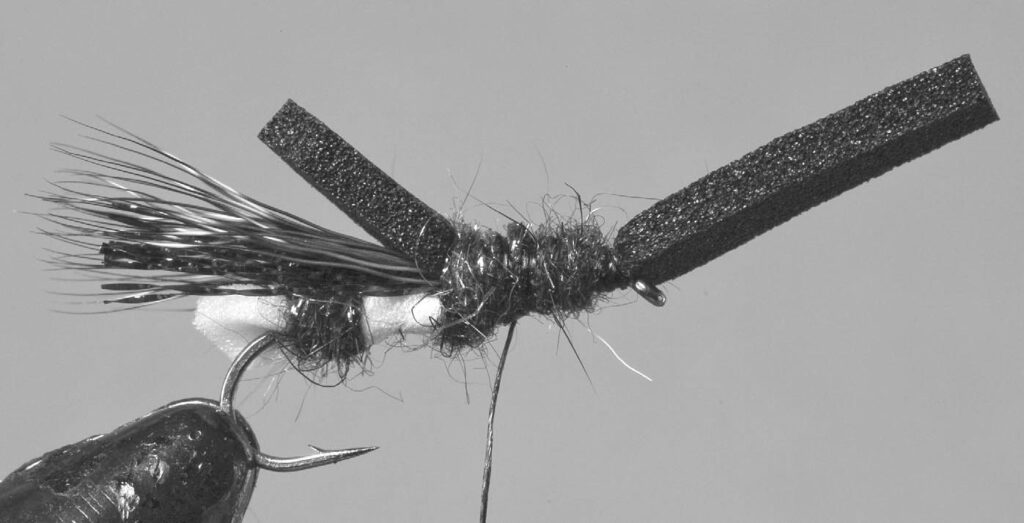
Step 7: Fold the remaining black foam rearward from the eye of the hook and tie it down to form a bullet head. Trim the excess to form a second and shorter point over the wing.
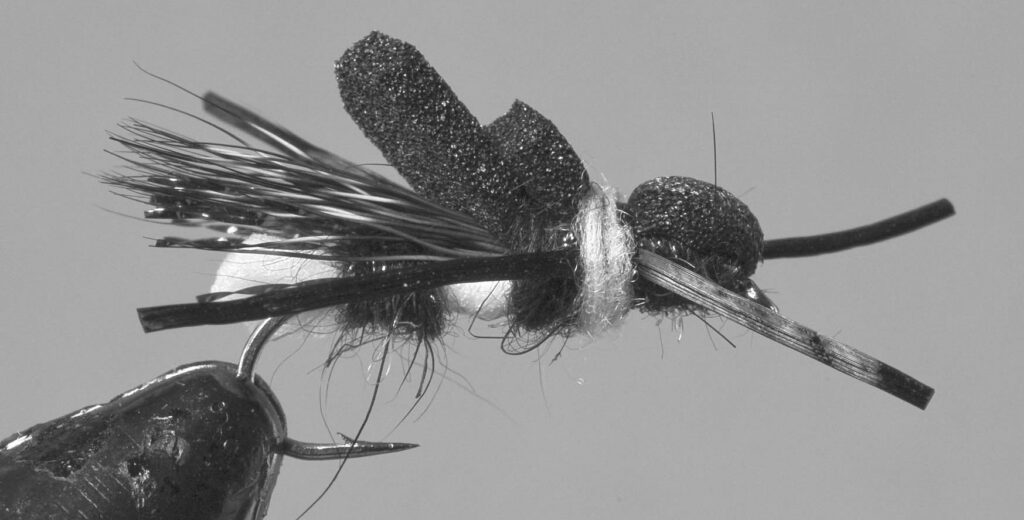
Step 8: Tie in two pieces of Stretch Floss on top of the hook at the rear of the bullet head with approximately three wraps of thread to form a set of legs. Manually adjust the legs to position them on the sides of the fly, forming an X in the fashion of a Madam X pattern. Trim the legs to size. Dub a small amount of yellow dubbing over the final thread wraps to create a final yellow segment and whip finish.



